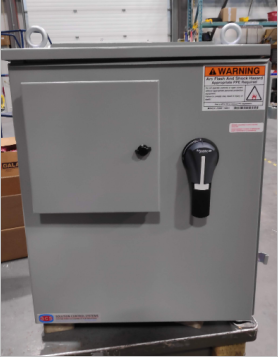VFD is an acronym for Variable Frequency Drive. It is a motor device used for controlling AC motor speed and torque by changing the input voltage and frequency in electro-mechanical systems. This device is present in appliances ranging from small to large systems. VFD is also referred to as an adjustable speed drive, AC drive, inverter, adjustable frequency drive, micro drive, or variable speed drive.
The variable frequency drive panel is used for regulating and controlling the electric motor’s and feed pump’s speed. It is typically used in large machines, like compressors, conveyors, drilling, pumping, etc. Frequency and electric motor’s speed are directly proportional to each other.

What is a Variable Frequency Drive (VFD)?
A Variable Frequency Drive (VFD) is an electronic device that controls the speed and torque of an electric motor by adjusting the frequency and voltage of its power supply. VFDs improve energy efficiency, reduce mechanical stress, and enhance process control in industrial applications. Commonly used in HVAC systems, pumps, conveyors, and manufacturing, VFDs optimize performance while reducing operational costs and extending equipment lifespan.
How Does a VFD Panel Work?
A VFD panel houses a Variable Frequency Drive (VFD) along with necessary components like circuit breakers, contactors, and cooling systems. It regulates motor speed by adjusting the frequency and voltage of the electrical supply, allowing precise control of torque and energy consumption. The panel protects the VFD from electrical faults, ensuring safe and efficient operation in industrial applications such as pumps, conveyors, and HVAC systems.
Key Benefits of Using VFD Panels
VFD panels offer several key benefits, including energy savings, as they adjust motor speed to match demand, reducing power consumption. They enhance process control by providing precise speed and torque adjustments. VFD panels also extend equipment lifespan by minimizing mechanical stress and wear. Additionally, they improve power factor, reduce inrush currents, lower maintenance costs, and provide better system protection against voltage fluctuations and overloads.
Main Components of a Variable Frequency Drive
A Variable Frequency Drive (VFD) consists of several key components:
- Rectifier: Converts AC power to DC.
- DC Bus: Stores and smooths DC power.
- Inverter: Converts DC back to variable AC for motor control.
- Control Unit: Manages speed, torque, and protection settings.
- Cooling System: Prevents overheating.
- Input/Output Interfaces: Enable communication with external controls and monitoring systems
Common Applications of VFD Panels
VFD panels are widely used across industries to enhance motor control and efficiency. Common applications include pumps, fans, and compressors in HVAC, water treatment, and manufacturing. They optimize conveyors and mixers in food processing and material handling. In oil & gas, they regulate drilling equipment and pipeline systems. VFD panels also improve energy savings in industrial automation, reducing wear on motors and extending equipment lifespan.
Why Use VFDs for Energy Efficiency?
Variable Frequency Drives (VFDs) improve energy efficiency by adjusting motor speed to match demand, reducing power consumption and eliminating unnecessary energy waste. Unlike traditional motor starters, which run at full speed, VFDs optimize performance, lowering electricity costs and minimizing wear on equipment. They also enhance power factor correction, reduce inrush currents, and contribute to sustainable operations by lowering overall carbon footprint in industrial and commercial applications.
Why choose VFD panels?
They incorporate two significant features – smooth start and stop capabilities, and adjustable speed, making VFDs more sturdy controllers. These panels offer benefits in terms of energy conservation and process control. Below are some advantages of variable frequency drive panel:
- Produces a high power factor.
- Conserves energy.
- Smooth and soft operation.
- Positions motor speed accurately.
- Uses less current during starting and operating.
Also Read: Solution Control Systems Brings You the Highly Advanced Variable Frequency Drive Panels
VFD’s Components
There are four primary components in every variable frequency drive – rectifier, intermediate circuit, inverter, and control unit. The rectifier changes the incoming alternating current (AC) to the direct current (DC). Using capacitors and inductors together, the DC supply is given to the intermediate circuit. The inverter converts the DC supply from the intermediate circuit into the alternating current (AC). Lastly, the control unit is the heart of the VFD, which monitors all operations.
VFDs Applications
The variable speed drive has several applications. It is used in several appliances, from small to large devices, like the cooling tower, boilers, constant air volume, elevators, conveyor systems, pump controls, and many other devices. Most customers buy VFD due to less power consumption and less setup cost features. Unlike all other controllers, VFDs are highly efficient in saving energy. Therefore, using VFDs in large plants is beneficial, as it reduces energy costs.
Using VFDs can save considerable amounts of electrical energy, as they control the speed by changing the frequency and voltage. VFD panels have an enclosed structure used for protecting applications from water and weather. These panels differ according to applications and functions.
Also Read- VFD Retrofit Options and Benefits for Units and Plants
Conclusion
VFD panels are essential for optimizing motor control, improving energy efficiency, and enhancing process automation across various industries. By adjusting motor speed to match demand, they reduce energy costs, extend equipment lifespan, and improve overall system performance. Whether in HVAC, manufacturing, or water treatment, VFD panels provide a reliable, cost-effective solution for achieving operational efficiency and sustainability in industrial applications.
